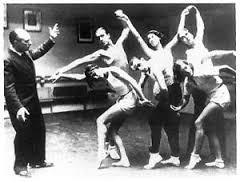Creativity is composed of four elements: originality, fluency, flexibility, and elaboration. Originality depends upon the novelty of an individual’s ideas. Fluency represents the sheer number of ideas that an individual can fabricate. Flexibility reflects difference in the kind of ideas produced. Finally, elaboration has to do with follow up – working out the details or perhaps seeing additional ways in which new things can be carried to the next level.
Arguably, Rudolf Laban possessed the first three attributes in abundance. His original notation and movement analysis systems provide inventive ways to capture and study the ephemeral phenomenon of human movement. Moreover, Laban believed that movement has meaning and that movement study provides insight into human behavior – two assertions that continue to be unorthodox.
Memoirs of Laban’s colleagues attest to his fluency. As Warren Lamb noted, Laban was endlessly “fashioning some new interpretation, trying out some new arrangement of data.” I can personally attest to Laban’s flexibility. Over two decades after publishing his notation system, Laban was still experimenting with different ways to notate the direction of a movement. In the Laban Archive, I found several additional sets of direction symbols – one drawing upon Roman numerals, one that appeared to incorporate Nordic rune-like symbols, one using letters, one combining letters and numbers, and so on.
 As for elaboration, Laban has a reputation for leaving this to students and colleagues. Notation is the classic example. Laban generated the basic format, but it took the painstaking work of Albrecht Knust, Ann Hutchinson Guest, and others to make it a practical recording system. Possessed by a creative energy, Laban developed a reputation for rushing ahead with ideas and leaving the execution to others. His protege Kurt Jooss complained that Laban never gave concrete answers. Associate Valerie Preston-Dunlop observed that Laban preferred to leave “the foundations of his work” in a “state of liquidity.” Geraldine Stephenson concurs, “Laban did not like the words: system, method, or technique.”
As for elaboration, Laban has a reputation for leaving this to students and colleagues. Notation is the classic example. Laban generated the basic format, but it took the painstaking work of Albrecht Knust, Ann Hutchinson Guest, and others to make it a practical recording system. Possessed by a creative energy, Laban developed a reputation for rushing ahead with ideas and leaving the execution to others. His protege Kurt Jooss complained that Laban never gave concrete answers. Associate Valerie Preston-Dunlop observed that Laban preferred to leave “the foundations of his work” in a “state of liquidity.” Geraldine Stephenson concurs, “Laban did not like the words: system, method, or technique.”
Laban’s colleagues seem to agree – he was original, flexible, and fluent. But Laban was not systematic. Yet perhaps there was more method in his pursuit of ideas than his colleagues perceived. Find out more in my next blog.
